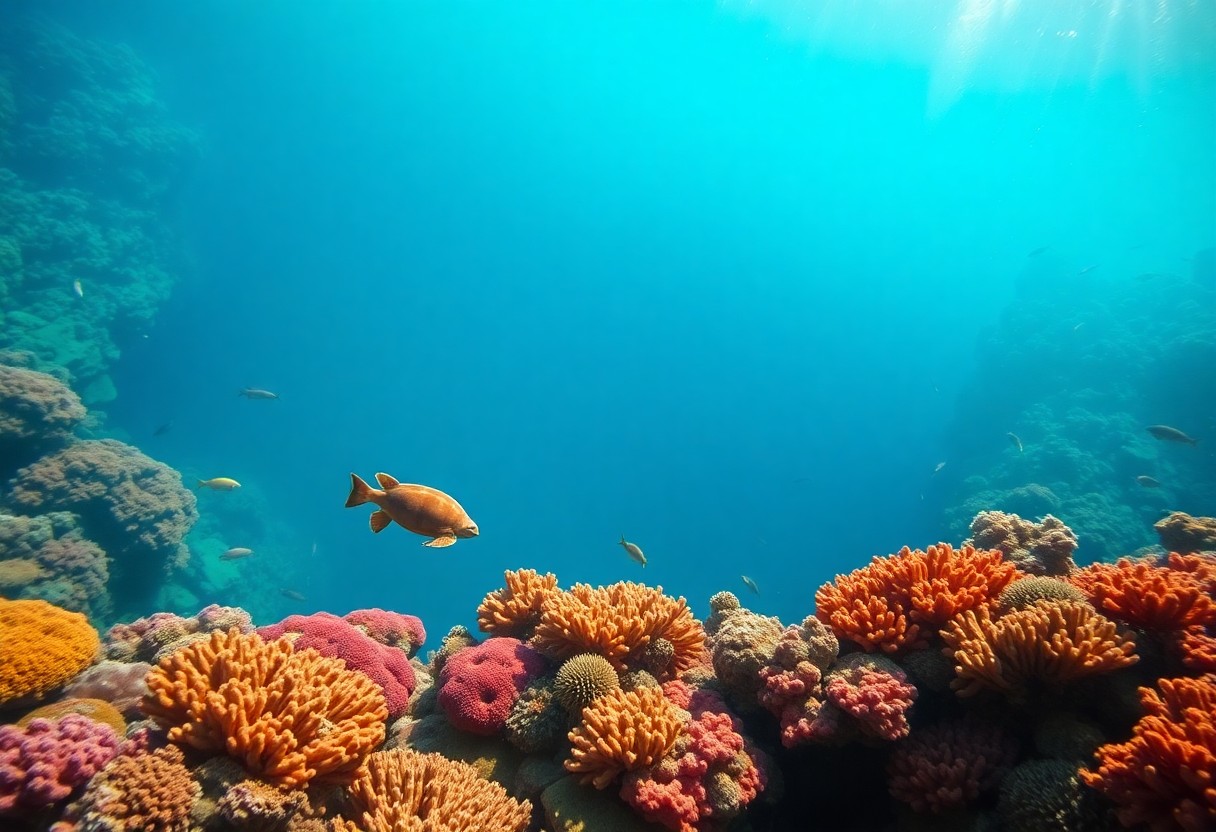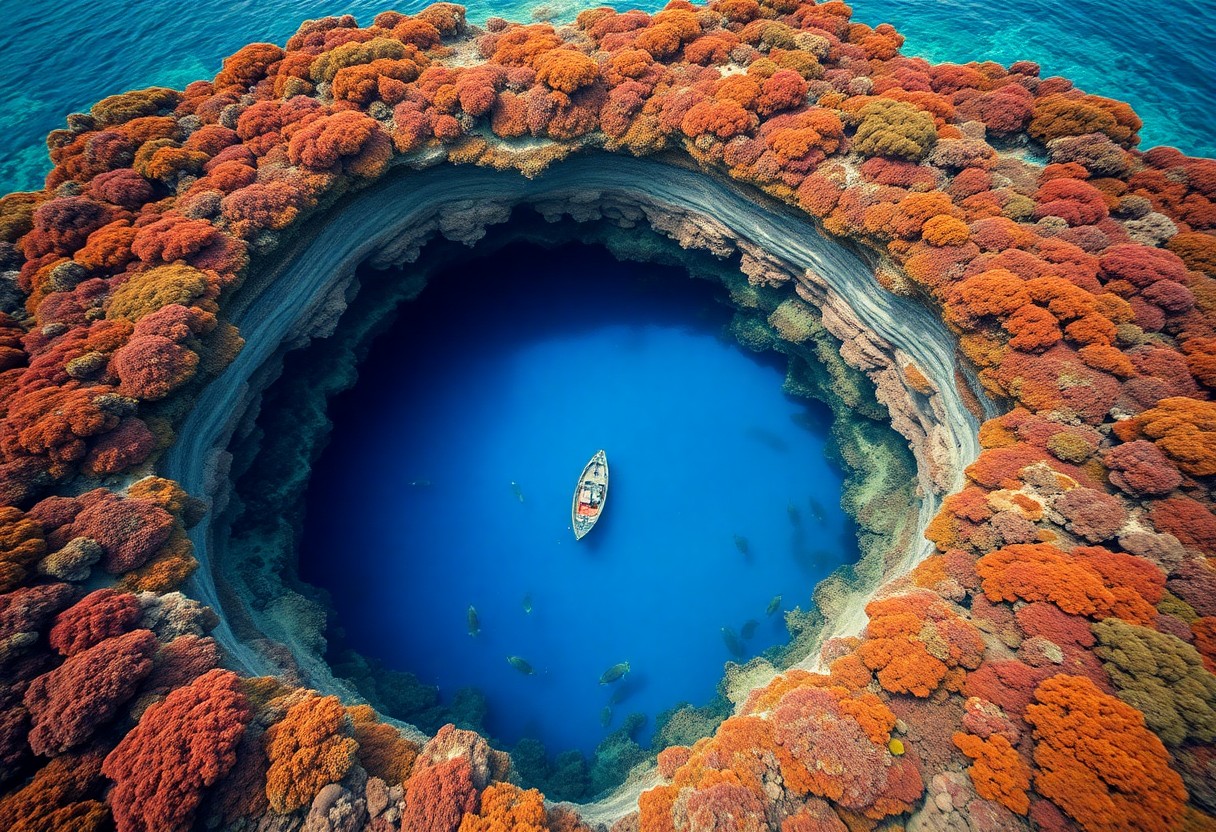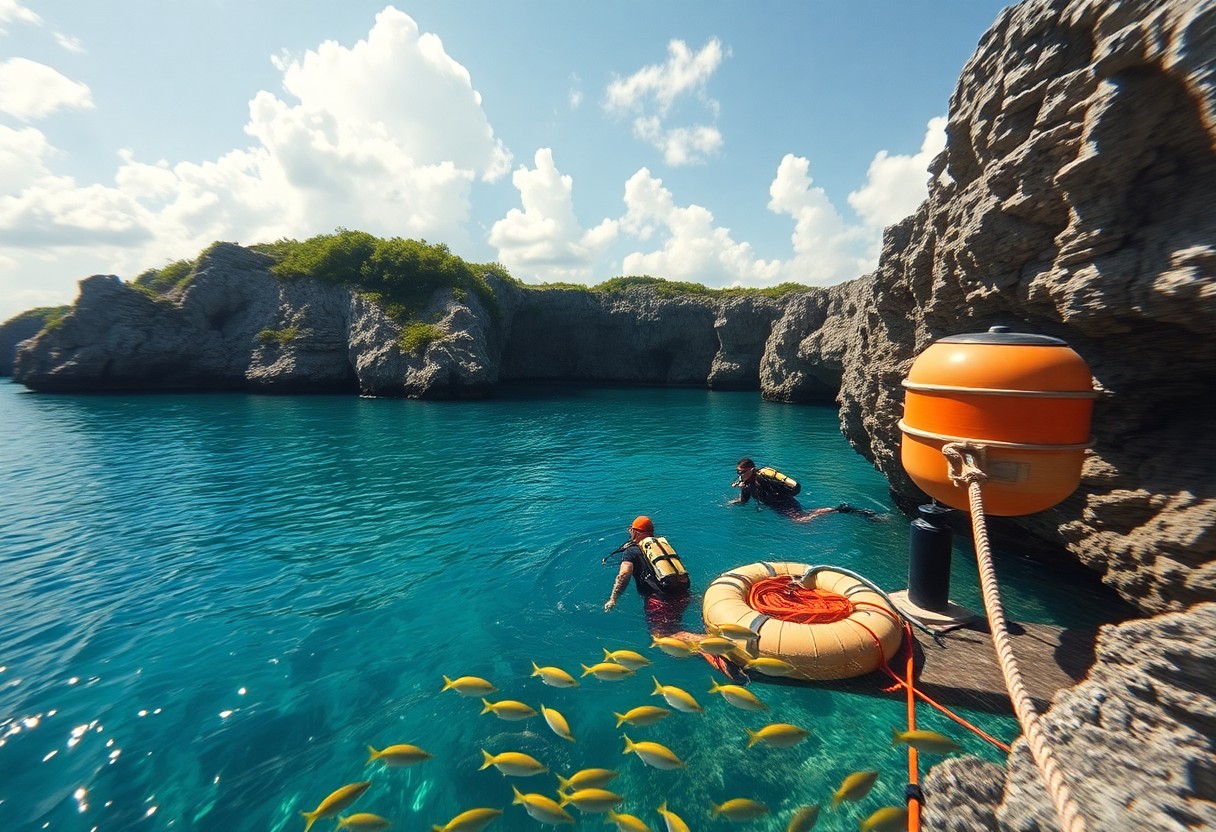For many divers and snorkelers, experiencing the stunning allure of the Great Blue Hole Belize is a dream come true. This remarkable location is recognized as a UNESCO World Heritage site, celebrated for offering extraordinary underwater experiences that are truly unmatched. The mesmerizing blue waters of this iconic marine sinkhole are complemented by its unique geological structures and a rich variety of marine life. As you plunge into the depths of this renowned Belize diving destination, you may encounter dangerous sharks and explore the vibrant coral reefs that flourish in this underwater paradise. This comprehensive guide will equip you with all the crucial information needed to elevate your blue hole diving adventure, ensuring both your safety and unforgettable memories throughout your dives.

Explore the Great Blue Hole: Nature’s Grand Underwater Treasure
The Great Blue Hole is widely regarded as one of the most captivating natural wonders on our planet. Created thousands of years ago during the last Ice Age, this massive marine sinkhole features an impressive depth of over 400 feet and spans roughly 1,000 feet in diameter. Its striking azure waters, combined with distinctive geological features, make it an essential destination for adventure enthusiasts eager to explore Belize. As you peer into its profound depths, you are drawn into a treasure trove of diverse marine life and stunning underwater vistas, solidifying its status as a top-tier choice for divers and snorkelers seeking extraordinary experiences.
Delve into the Geological History and Vibrant Ecosystem
The Great Blue Hole is a fascinating geological phenomenon that has emerged through a series of complex natural processes. Over time, fluctuations in sea levels transformed what was once a limestone cave system into the vast underwater sinkhole we see today. This unique ecosystem supports a wide array of marine life, including vibrant corals, powerful reef sharks, and numerous fish species, highlighting the delicate balance of life thriving within this expansive underwater cavern. Every visit offers a chance to witness the incredible biodiversity that inhabits this extraordinary site, emphasizing its importance for ongoing marine conservation efforts.
The Magnetic Appeal of the Great Blue Hole for Divers and Snorkelers
Your journey into the Great Blue Hole, whether diving or snorkeling, promises an extraordinary adventure filled with breathtaking sights and unforgettable experiences. With visibility often exceeding 150 feet, you will have the chance to encounter a myriad of marine species flourishing in their natural habitats. The draw of the Great Blue Hole lies not only in its extraordinary geological structure but also in the diverse marine life that surrounds it, along with the opportunity to explore impressive stalactites and stalagmites formed in the depths of the cave. This captivating combination of stunning visuals and exhilarating underwater experiences makes it a bucket-list destination for divers and snorkelers alike.
What makes the diving and snorkeling experience at the Great Blue Hole irresistibly appealing is the unique blend of awe-inspiring visuals and exhilarating encounters. Divers can maneuver through caverns adorned with massive stalactites, while snorkelers float above vibrant coral formations teeming with marine life. Furthermore, diving in the Great Blue Hole allows for the chance to spot curious sharks and other dynamic sea creatures that inhabit this extraordinary ecosystem. Few dive sites around the world can offer such an enchanting mix of geological wonders and ecological richness, ensuring an unforgettable experience for adventurers in search of the ultimate underwater escapade.
Essential Skills and Preparation for an Unforgettable Diving Experience
Preparation is crucial before embarking on your diving adventure in the Great Blue Hole. Start by familiarizing yourself with the marine environment and understanding the potential underwater conditions you may face, including currents and varying levels of visibility. Practicing buoyancy control and equalization techniques will significantly enhance your experience, allowing you to explore the depths with confidence and ease. Additionally, having a thorough understanding of dive planning, safety protocols, and communication signals will help ensure an enjoyable and safe adventure as you marvel at the stunning underwater beauty that awaits you.
Gather the Right Equipment: Essential Gear for Diving and Snorkeling
Your diving experience at the Great Blue Hole heavily relies on the quality of your equipment. Essential gear includes a wetsuit to maintain warmth, a buoyancy control device (BCD) for stability, a regulator for breathing, and a mask and snorkel for surface exploration. Don’t overlook the importance of packing fins to facilitate movement through the water and weights to assist with your descent. High-quality underwater cameras are also invaluable for capturing breathtaking images of marine life and stunning underwater scenes, so make sure you have the right gear to maximize your adventure and create lasting memories.
Understanding Required Certifications and Experience for Diving
To fully enjoy the diving opportunities presented at the Great Blue Hole, you typically need at least an Open Water Diver certification, which ensures you possess the foundational skills necessary for safe diving. Many dive shops in Belize offer guided tours for less experienced divers, allowing you to explore this incredible site alongside a certified instructor. It’s important to note that advanced dives may necessitate higher certification levels, such as Advanced Open Water or Deep Diver certifications, which provide you with the skills needed for more challenging underwater environments and deeper dives.
While Open Water Diver certification is often adequate for the shallower sections of the Great Blue Hole, venturing into deeper areas requires additional experience. Advanced divers are advised to have logged at least 24 dives before attempting the depths of the Great Blue Hole. This experience ensures you have the necessary skills to manage potential challenges, such as depth perception and effective dive planning. If you’re keen to enhance your diving experience, consider pursuing specialty certifications focused on deep diving or wreck diving, which can significantly broaden your skill set and boost your confidence underwater.
Uncovering Stunning Dive Spots: The Wonders Beneath the Surface
Every exploration of the Great Blue Hole reveals a captivating world just beneath the surface, with depths reaching 407 feet. As you descend, breathtaking stalactites and unique underwater formations greet you, telling the geological story of the region. Visibility can be exceptional, often exceeding 100 feet, allowing you to fully appreciate the vibrant colors and remarkable underwater landscapes. While the experience is awe-inspiring, diving here demands skill and careful preparation, as conditions can be unpredictable; therefore, advanced certification is highly recommended to fully enjoy this magnificent underwater sanctuary.
Exciting Marine Encounters: Meeting Sharks, Turtles, and More
Diving in the Great Blue Hole presents thrilling encounters with some of the ocean’s most fascinating creatures. You can expect to spot bull sharks lurking in the depths, alongside graceful loggerhead turtles gliding through the water. Schools of vibrant tropical fish create a dazzling array of color, while occasional sightings of rays and nurse sharks enhance the thrill of your underwater adventure. The diverse marine ecosystem ensures that each dive will present you with new and unforgettable wildlife encounters, further enriching your experience.
Exploring Must-Visit Dive Sites Beyond the Great Blue Hole
While the Great Blue Hole undoubtedly stands out as a premier attraction, Belize boasts numerous exceptional dive sites that should not be overlooked. Locations such as Shark Ray Alley offer exhilarating snorkeling experiences alongside nurse sharks and stingrays, while the Hol Chan Marine Reserve captivates visitors with its rich biodiversity, showcasing everything from vibrant coral gardens to large pelagic fish. For a unique diving experience, make your way to Turneffe Atoll, where you can explore stunning wall dives and encounter exotic species in their lush habitats. Each of these locations provides a different perspective of the underwater world, establishing Belize as a diver’s paradise. Additionally, visiting sites like Glover’s Reef allows you to explore patch reefs teeming with marine life, ensuring your underwater adventures are filled with wonder and amazement.

Planning Your Trip: Logistics and Best Practices for an Enjoyable Experience
Planning your adventure to the Great Blue Hole requires careful consideration of logistics and best practices to ensure a seamless experience. Start by determining the duration of your stay, as diving or snorkeling around the Blue Hole may necessitate at least a couple of days. Secure accommodations conveniently located in Belize City or San Pedro to facilitate easy access. Take into account the travel time to the Blue Hole, which typically involves a boat trip of up to two hours. Finally, pack appropriately for both diving and snorkeling adventures, including your own gear if desired, and ensure you have travel insurance that covers diving activities for added peace of mind during your trip.
Optimal Timing: Seasonal Factors Influencing Ideal Diving Conditions
The prime time to visit the Great Blue Hole is from April to June and September to November, when weather conditions generally stabilize, water temperatures remain warm, and visibility peaks. During these months, you’re more likely to encounter vibrant marine life and clearer waters, creating an optimal environment for diving and snorkeling. It’s advisable to avoid the peak hurricane season, which spans from June to November, as adverse weather conditions may disrupt your plans and affect diving conditions.
Choosing the Right Tour Operator: Essential Factors to Consider
Selecting the appropriate tour operator is critical for a memorable experience at the Blue Hole. Ensure they possess the necessary credentials, such as certification from the Belize Tourism Board, and have extensive experience leading excursions to the Great Blue Hole. Look for operators that prioritize safety by providing high-quality gear and knowledgeable guides who can share valuable insights about the area’s rich history and ecology. Reading reviews from previous customers on platforms like TripAdvisor can help you assess the reputation and reliability of potential operators.
Diving deeper into your selected tour operators provides valuable insights into their services. Opt for those with a solid reputation for safety and environmental stewardship, especially given that the Blue Hole is a sensitive ecosystem. Some operators offer small group sizes, enhancing your diving experience by providing personalized attention and ample space underwater. Additionally, inquire about extra services like buffet lunches, refreshments, or additional activities, such as exploring nearby attractions, to enrich your trip to the Blue Hole. The right operator will ensure not only a safe dive but also a memorable adventure filled with stunning underwater scenery and vibrant marine life.

Emphasizing Safety: Ensuring a Secure and Enjoyable Diving Experience
Safety must always be the top priority while exploring the Great Blue Hole in Belize. Taking the time to understand local protocols and preparing for any situation can significantly enhance your adventure, allowing you to focus on the breathtaking underwater vistas surrounding you. Equip yourself with knowledge about your dive operator’s safety measures, ensure your equipment is in excellent working condition, and maintain awareness of your surroundings. By prioritizing safety, you can enjoy a thrilling yet secure diving or snorkeling experience in this magnificent natural wonder.
Familiarizing Yourself with Dive Safety Protocols and Emergency Procedures
Before embarking on your Belize diving journey, it is essential to familiarize yourself with standard diving safety protocols and emergency procedures. Dive masters typically conduct pre-dive briefings that outline the rules of engagement, ensuring you understand the importance of buddy systems, maintaining buoyancy, and monitoring your air supply throughout the dive. Being aware of emergency procedures, including decompression stops and recognizing the symptoms of decompression sickness, will enhance your overall safety. Choosing a reputable dive operator that prioritizes safety can significantly contribute to a secure and enjoyable underwater journey.
Weather Patterns and Their Impact on Diving Conditions
Weather patterns can significantly affect your diving experience in the Great Blue Hole. Favorable conditions typically include calm seas, clear skies, and good visibility. Storms, high winds, and rain can reduce visibility and create strong currents, making diving hazardous. Generally, the dry season from December to April offers the most stable weather, while the rainy season (June to November) poses potential risks due to tropical storms. Closely monitoring weather forecasts ensures you select the optimal time for your adventure, promoting both safety and enjoyment during your diving experience.
Typically, the best opportunities for diving in the Great Blue Hole occur during the dry season when weather conditions are most reliable. This period not only provides calmer waters but also enhances visibility, allowing you to fully appreciate the stunning marine life and geological formations beneath the surface. Frequenting local dive shops and staying updated with meteorological sources can help keep you informed about any changes in weather patterns, ensuring your plans align with the best diving conditions for a safer and more memorable experience.
Embrace the Adventure: Discover the Wonders of the Great Blue Hole
Exploring the Great Blue Hole Belize is a once-in-a-lifetime journey that promises unforgettable memories both above and beneath the water’s surface. With its rich marine life, stunning underwater caverns, and the thrill of Belize diving, this iconic location truly deserves a place on every diver’s bucket list. As you prepare for your journey, remember to prioritize safety and detailed planning to ensure you make the most of your adventure. From utilizing local guides to selecting the perfect timing for your visit, every aspect plays a vital role in crafting an extraordinary dive or snorkeling experience. Embrace the allure of the Blue Hole and discover a world filled with breathtaking beauty and wonder that awaits beneath the waves.
Your Inquiries Addressed: Frequently Asked Questions About the Great Blue Hole
Q: What contributes to the fame of the Great Blue Hole in Belize?
A: The Great Blue Hole is a massive underwater sinkhole located off the coast of Belize, forming part of the Belize Barrier Reef Reserve System, which is designated as a UNESCO World Heritage site. It is renowned for its stunning deep blue color, unique geological formations, and rich marine biodiversity, drawing divers and snorkelers from all over the globe. The Blue Hole is celebrated for its remarkable visibility and profound depths, presenting adventurers with opportunities to observe various marine life, including sharks, rays, and vibrant coral formations.
Q: What are the ideal times for diving in the Great Blue Hole?
A: The best times for diving in the Great Blue Hole occur during the dry season, which runs from late November to mid-April. During this period, weather conditions are generally calm, and underwater visibility is at its peak, often exceeding 60+ feet. It is advisable to plan your diving excursions in advance, particularly during peak tourist months such as December and March, to secure your spot on popular dive boats.
Q: Can novice divers enjoy the Great Blue Hole, and what certification is required?
A: While the Great Blue Hole is a world-renowned dive site, it is recommended that divers possess at least an Advanced Open Water certification or equivalent due to its unique conditions and depths exceeding 400 feet. However, beginner divers can partake in snorkeling opportunities around the Blue Hole and nearby dive sites, allowing them to experience vibrant marine life without requiring extensive diving training or experience.
Q: What should I bring for diving or snorkeling at the Great Blue Hole?
A: When preparing for a diving or snorkeling trip to the Great Blue Hole, it’s essential to pack several key items. Ensure you bring your diving gear, including a wetsuit (consider a 3mm suit for warmth), mask, snorkel, and fins. Don’t forget sunscreen, a hat, sunglasses, and a refillable water bottle to stay hydrated. A camera or underwater housing is also highly recommended to capture the breathtaking marine life and coral formations you’ll encounter during your adventure.
Q: Are there guided tours available for diving and snorkeling in the Great Blue Hole?
A: Yes, numerous guided tours are available for those wishing to dive or snorkel at the Great Blue Hole. Many dive shops and tour operators in Belize offer day trips that include diving, snorkeling, and exploration of nearby attractions such as Half Moon Caye and Lighthouse Reef. These tours typically provide all necessary equipment, experienced dive instructors or guides, and comprehensive safety measures for a fulfilling experience in the stunning waters of Belize.
The Article Great Blue Hole Belize: Ultimate Diving and Snorkeling Guide appeared first on Belize Travel Guide
The Article Great Blue Hole Belize: Your Essential Diving and Snorkeling Guide Was Found On https://limitsofstrategy.com





No responses yet